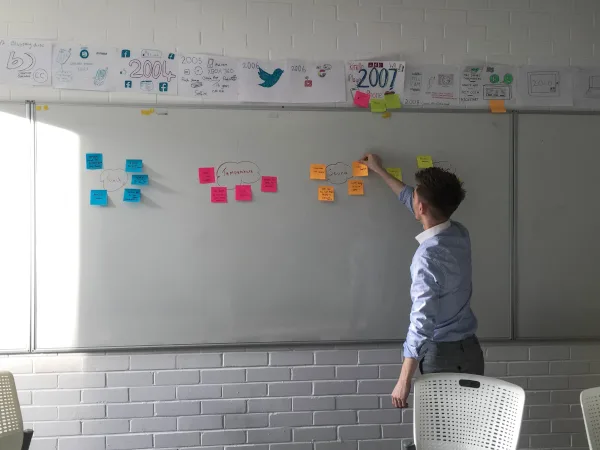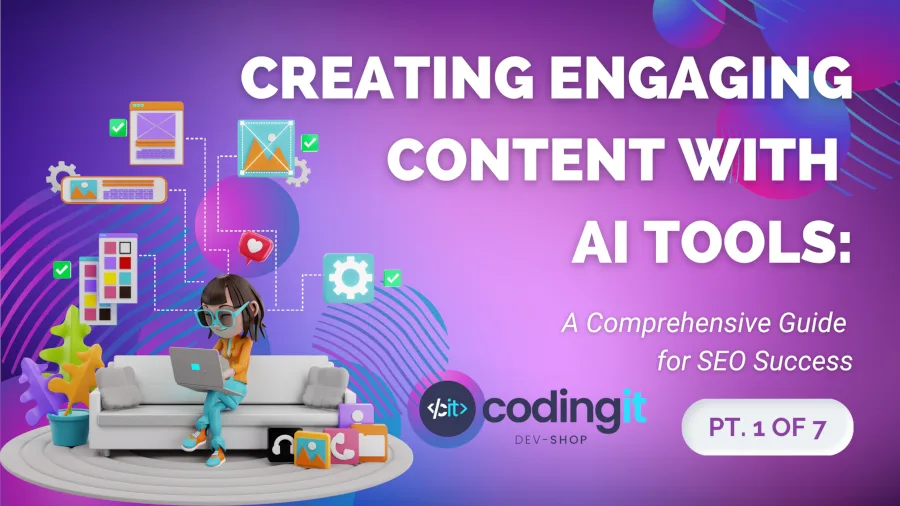Content creation has emerged as a pivotal element in the success of marketing and branding efforts. However, with the ever-increasing competition for online visibility, businesses must find ways to stand out amidst the noise and connect with their audience on a deeper level. This is where the power of artificial intelligence (AI) comes into play.
AI has revolutionized numerous industries, and content creation is no exception. By leveraging AI tools, businesses can unlock a world of possibilities, enabling them to create compelling, relevant, and SEO-friendly content that resonates with their audience. This article is designed to equip you with the knowledge and skills to harness the immense potential of AI in content creation.
By following the comprehensive guidance provided in this series of articles, this is only part 1 of the 7 part series, you will gain a deeper understanding of AI-powered content creation and its immense potential for driving organic traffic and user engagement. Equipped with practical knowledge and valuable insights, you will be empowered to leverage AI tools to create compelling and optimized content that sets you apart in the hyper-competitive digital landscape.
Now, let’s begin exploring the world of AI-powered content creation and unlocking the opportunities it holds!
- Defining Your Content Strategy
- Alignment with Business Goals
- Targeted Audience Engagement
- Optimized SEO Performance
- Consistency and Branding
- Efficiency and Scalability
- Step 1: Identifying Target Audience and User Intent
- Step 2: Establishing Clear Content Goals
- Step 3: Conducting Competitor Analysis
- Step 4: Aligning AI Tools with Content Strategy
- Conclusion
Defining Your Content Strategy
Defining your content strategy is the first and most important step on this automatic content creation journey. In order to generate AI content that is received well, we must clearly define the parameters that are going to serve as the guiding principles of the content. Let’s explore the significance of having clear direction during this process:
Alignment with Business Goals
By defining your content strategy, you establish clear objectives and align your AI-generated content with your broader business goals. This ensures that the AI-generated content serves a purpose and contributes directly to your marketing, branding, or sales objectives. It helps you maintain consistency and coherence in your content, making it more impactful and effective.
Targeted Audience Engagement
A well-defined content strategy enables you to identify your target audience and understand their needs, preferences, and pain points. With this understanding, you can use AI tools to generate content that specifically resonates with your audience, addresses their concerns, and provides valuable insights or solutions. This targeted approach increases the chances of engaging your audience and building strong connections with them.
Optimized SEO Performance
AI-generated content can play a significant role in improving your website’s search engine optimization (SEO) performance. When you define your content strategy, you can identify relevant keywords, topics, and themes that align with your business and target audience. By incorporating these elements into your AI-generated content, you can optimize it for search engines, increase its visibility, and attract organic traffic to your website.
Consistency and Branding
Defining your content strategy allows you to establish consistent branding across all AI-generated content. You can set guidelines for tone, style, voice, and messaging that align with your brand identity. This consistency helps in building brand recognition, credibility, and trust among your audience, regardless of whether the content is human-created or AI-generated.
Efficiency and Scalability
A content strategy for AI-generated content ensures that you have a systematic approach in place to generate, manage, and scale your content production. By defining the types of content, content formats, and channels to focus on, you can streamline your content creation process using AI tools. This efficiency allows you to produce high-quality content at scale, saving time and resources while maintaining relevance and consistency.
In summary, defining your content strategy is mission critical to generating AI content that actually has value! It is crucial for aligning your content with business goals, engaging your target audience, optimizing SEO performance, maintaining consistency and branding, and ensuring efficiency and scalability. By harnessing the power of AI within a well-defined strategy, you can unlock the full potential of AI-generated content and drive meaningful results for your business.

Step 1: Identifying Target Audience and User Intent
In the vast digital landscape, where information flows abundantly, capturing the attention of your intended audience is no easy task. To create engaging content that resonates with your readers, it is essential to start by identifying your target audience and understanding their intent. To help establish what their intent is, we must first view the digital world from their side of the computer monitor. Some questions that are often asked are:
- Where would I go if I wanted to know more about this?
- What resources exist that are trustworthy or credible?
- What do I love or hate about how the information is presented?
- Is the information I am presented easy to understand?
- Can I ask questions to the authors or find additional information if I want?
- Is there a group not being served by the current resources available?
By gaining a deep understanding of who your audience is and what they are looking for, you can craft content that meets their needs and fulfills their desires.
Target audience identification involves meticulous research and analysis. You must go beyond surface-level demographics and delve into their preferences, pain points, and motivations. Explore their online behavior, social media interactions, and engagement patterns to develop a comprehensive picture of who they are and what drives them.
Once you have identified your target audience, understanding their intent becomes crucial. What are they seeking when they come across your content? Are they looking for information, entertainment, or inspiration? By deciphering their intent, you can align your content strategy to deliver exactly what they desire, ensuring your message strikes a chord with their expectations.

Step 2: Establishing Clear Content Goals
To achieve success in content creation, you must establish clear and measurable goals that align with your broader business objectives. These goals will serve as guideposts, directing your content strategy and providing a means to evaluate your progress. Without clear goals, even the most well-crafted content can miss its mark.
When setting content goals, consider both quantitative and qualitative aspects. Quantitative goals may include metrics such as website traffic, engagement rates, and conversion rates. On the other hand, qualitative goals focus on the impact and perception of your content, such as brand reputation, thought leadership, and audience satisfaction. Each goal should be specific, measurable, achievable, relevant, and time-bound (SMART).
For instance, a quantitative goal could be to increase organic website traffic by 30% within six months. This goal is specific, measurable, and time-bound. Additionally, a qualitative goal could be to establish your brand as a trusted authority in your industry by publishing thought-provoking and informative articles that generate discussions and shares.
By setting clear content goals, you create a framework that allows you to track progress, make data-driven decisions, and refine your strategy along the way. These goals provide focus and ensure that your content efforts are purposeful and aligned with your overall business objectives.

Step 3: Conducting Competitor Analysis
To gain a competitive edge and differentiate your content from others in your industry, conducting a thorough competitor analysis is essential. By understanding what your competitors are doing, you can identify gaps, uncover unique angles, and refine your content strategy.
Conducting a thorough competitor analysis allows you to identify their strengths, weaknesses, strategies, and content gaps. Start by identifying your direct and indirect competitors. Direct competitors offer similar products or services to the same target audience, while indirect competitors may serve a different need but still attract the attention of your potential customers, thus eating up traffic and attention online whenever they can. This knowledge provides you a unique perspective on the totality of the digital landscape to assist you in your quest of differentiating yourself, identifying untapped content opportunities, shedding light on an audience that was looked over, and giving you the license to refine your content strategy to these groups.
After uncovering who you are competing with and diving into their online platforms, you must keep going. Go so far as to deeply analyze their content marketing efforts, social media presence, and search engine rankings. By dissecting their approach, you can identify areas where you can outshine them and uncover unique angles to capture your audience’s attention. Are they delivering engaging and informative pieces that resonate with their audience? Look for patterns in their messaging, tone, and style. Consider their distribution channels, such as email newsletters, social media platforms, or industry-specific forums.
Let’s illustrate this with an example. Imagine you run a travel blog and your competitors include established travel websites and influential travel bloggers. By analyzing their content, you may discover that they often focus on destination guides and travel itineraries. To differentiate yourself, you could explore alternative content angles, such as sustainable travel tips, local cultural experiences, or off-the-beaten-path destinations that are underrepresented in existing content.
Furthermore, keep an eye on emerging trends and topics in your industry. Monitor social media discussions, online forums, and industry publications to stay informed about the interests and conversations within your target audience. Sources such as Reddit, AnswerthePublic, Quora and others can serve as unique opportunities to gain insight into your industry. This knowledge will help you adapt your content strategy, capitalize on opportunities, and remain relevant in a dynamic landscape.

Step 4: Aligning AI Tools with Content Strategy
With the advancements in AI technology, incorporating AI tools into your content strategy can provide substantial benefits. However, to maximize their effectiveness, it is crucial to align the selection and implementation of these tools with your overarching content strategy.
Consider your identified target audience, their intent, and your established content goals when evaluating AI tools. Look for tools that offer features tailored to your specific needs, such as content generation, optimization, or personalization. For example, if your goal is to streamline your content creation process and increase productivity, you might explore AI-powered content generation tools that can assist in generating article outlines or suggesting topic ideas.
Evaluate the quality and reliability of AI tools by researching user reviews, case studies, and expert opinions. Seek tools that have a track record of delivering accurate and valuable results. Consider the scalability and compatibility of the tools with your existing systems and workflows.
Integration of AI tools into your content strategy requires a thoughtful approach. Determine how these tools can enhance your content creation process, streamline workflows, and amplify your capabilities. For instance, you may leverage AI-powered sentiment analysis tools to gain insights into your audience’s emotions and tailor your content accordingly.
Let’s revisit the B2B software company example. Suppose your content strategy involves providing informative blog articles to educate your target audience about accounting best practices. In this case, you might explore AI tools that can assist in optimizing your content for SEO, improving readability, or suggesting relevant keywords. By aligning AI tools strategically, you can enhance the quality, efficiency, and impact of your content creation efforts.
By defining your target audience, establishing clear content goals, conducting thorough competitor analysis, and aligning AI tools with your content strategy, you lay a solid foundation for success in AI-powered content creation. In the next chapter, we will dive deeper into the landscape of AI tools, exploring their functionalities, evaluating their quality, and showcasing case studies of successful implementation. Prepare to unlock the true potential of AI in transforming your content creation process and driving SEO success.
Conclusion
We hope this first article of the AI Generated Content Series has helped you understand the steps necessary to defining your own content strategy.
The keys to success are to be honest, objective, and remain customer-centric with all your responses. Carrying this advice through to the next article : “Choosing the Right AI Tools for Content Creation” will ensure that you also find the right tool to help you achieve your goals.
Should you want a professional team of AI experts to help your business implement AI tools more thoroughly, then look no further than the amazing team at CodingIT. We have decades of experience in building Machine Learning Applications, Auditing AI use within companies, and building or training Neural Networks. Reach out to us and tell us how we can best serve you!
